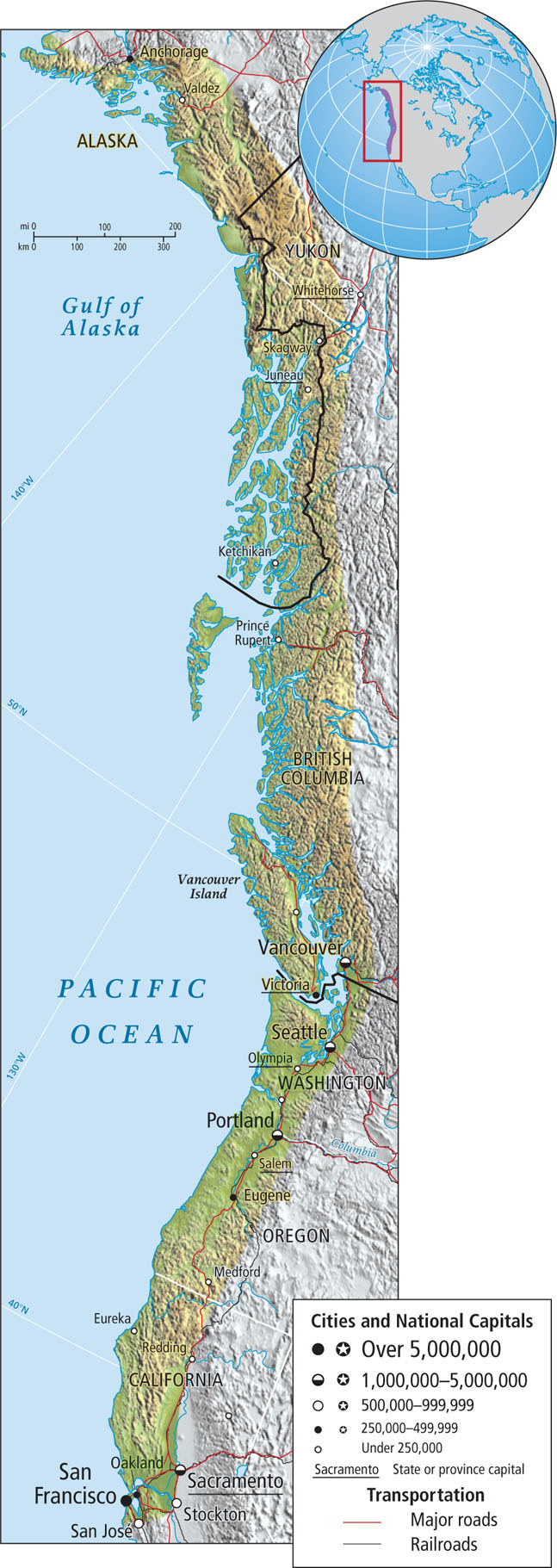The Pacific Northwest
Once a fairly isolated region, the Pacific Northwest (Figure 2.50) is now at the center of debates about how North America should deal with environmental and development issues. The economy in much of this region is shifting from logging, fishing, and farming to information technology industries. As this is happening, its residents’ attitudes about their environment are also changing. Forests that were once valued primarily for their timber are now also prized for their recreational value, especially their natural beauty and their wildlife, both of which are threatened by heavy logging. Energy, needed to run technology and other industries, is now more than ever a crucial resource for the region.

118
The physical geography of this long coastal strip consists of fjords and islands, mountains and valleys. Most of the agriculture, as well as the largest cities, are located in the southern part, in a series of lowlands lying east of the long, rugged coastal mountain ranges that extend north and south. Throughout the region, the climate is wet. Winds blowing in from the Pacific Ocean bring moist and relatively warm air inland, where it is pushed up over the mountains, resulting in copious orographic rainfall throughout the area and seasonal snowfall in the north. The close proximity of the ocean gives this region a milder climate than is found at similar latitudes farther inland. In this rainy, temperate zone, enormous trees and vast forests have flourished for eons (see Figure 2.5A). The balmy climate in much of the region, along with the spectacular scenery, attracts many vacationing or relocating Canadians and U.S. citizens.
Older Extractive Industries
Pacific Northwest logging provides most of the construction lumber and an increasing amount of the paper used in North America. Lumber and wood products are also important exports to Asia, and the lumber industry is responsible directly and indirectly for hundreds of thousands of jobs in the region. As the forests shrink, environmentalists are harshly critical of the logging industry for such practices as clear-cutting (see Figure 2.5B–D), which destroys wild animal and plant habitats, thereby reducing species diversity, and leaves the land susceptible to erosion and the remaining adjacent forests susceptible to diseases and pests. The criticisms of clear-cutting are obvious and legitimate; the more expensive alternative logging method of selective cutting is still disruptive to habitats and does not preserve forest diversity, but it is healthier for soils and maintains some diversity of fauna and flora.  36. WASHINGTON SALMON FESTIVAL REPORT
36. WASHINGTON SALMON FESTIVAL REPORT
Disputes also rage over how to acquire sufficient energy for the region. Large hydroelectric dams in the Pacific Northwest have attracted industries that need cheap electricity, particularly aluminum smelting and associated manufacturing industries in aerospace and defense. These industries are major employers, but their demand for labor is erratic and involves frequent periodic layoffs. In addition, another major employer in the region, the fishing industry, finds fault with hydroelectric dams because they block the seasonal migrations of salmon to and from their spawning grounds, so some of the region’s most valuable fish cannot produce young.  33. SOLAR POWER
33. SOLAR POWER
Newer IT Industries
Given the environmental impacts of the logging and hydroelectric industries, it is not surprising that many people in the region are enthusiastic about the increasing role of information technology within the major urban areas of the Pacific Northwest: San Francisco, Portland, Seattle, and Vancouver. With Silicon Valley just outside San Francisco and with a growing number of IT companies around Seattle, the Pacific Northwest is a world leader in information technology. However, IT firms produce hazardous waste such as lead and other heavy metals used in circuit boards, and they are particularly dependent on secure and steady sources of electricity—whether from water power, gas, oil, coal, or nuclear fuels—that have significant negative environmental impacts.  38. SEATTLE EXPORTS
38. SEATTLE EXPORTS
The Pacific Northwest, and particularly its major cities, often leads the rest of the United States and Canada in social and economic innovation. This role is currently illustrated by the region’s growing connections to Asia. The adjustment of a predominantly Euro-American society to large numbers of Asian immigrants has been well underway along the Pacific Coast for many decades. This transition has been accompanied by the growing importance of the countries around the Pacific Rim as trading partners. Vancouver, Seattle, Portland, and San Francisco are increasingly oriented toward Asia, not just in the trade of forest products, but in banking and tourism, and in the design and manufacture of IT equipment, some of which is now being outsourced to Asia.
THINGS TO REMEMBER
 Information technology firms have become a major source of the subregion’s economy and are challenging the traditional logging, fishing, farming, and hydroelectric industries for primacy, especially given the latter’s detrimental impacts on the environment.
Information technology firms have become a major source of the subregion’s economy and are challenging the traditional logging, fishing, farming, and hydroelectric industries for primacy, especially given the latter’s detrimental impacts on the environment. The Pacific Northwest, and particularly its major cities, often lead the rest of the United States and Canada in social and economic innovation.
The Pacific Northwest, and particularly its major cities, often lead the rest of the United States and Canada in social and economic innovation. The Pacific Northwest continues to grow and adjust its economic and cultural ties with countries across the Pacific as large numbers of Asian immigrants move to the subregion.
The Pacific Northwest continues to grow and adjust its economic and cultural ties with countries across the Pacific as large numbers of Asian immigrants move to the subregion. The growth of the global economy has boosted IT industries in the Pacific Northwest at the same time that Asian markets for raw materials from the region have opened up.
The growth of the global economy has boosted IT industries in the Pacific Northwest at the same time that Asian markets for raw materials from the region have opened up.